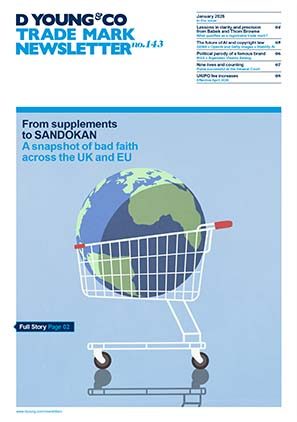First Grade International v KO-CO Foods: indirect confusion
In this case, the UKIPO held that there was no likelihood of direct confusion between the figurative KO-CO application and the earlier koko and KOKO DESIRE marks, but that there was a likelihood of indirect confusion.
Background
The applicant, KO-CO Foods Ltd, applied to register KO-CO as a figurative mark, with a small image of a palm tree in the second “O” of KO-CO (as shown below), for various chocolate, cocoa and confectionery goods in class 30.

The application was opposed by First Grade International Limited on the basis of a likelihood of confusion with its earlier UK trade mark registrations for koko, including the figurative koko marks which feature palm trees over the first letter “o” in koko (as below left) and a palm tree over part of the “k” and second “o” in koko (as shown below right) and the word mark KOKO DESIRE – the opponent’s marks cover classes 29 and 30, in particular coconut-based goods, puddings and desserts.

The evidence
The opponent filed evidence of use to support a claim that its marks had an enhanced distinctive character, whilst the applicant submitted evidence to support its defence that there was no likelihood of confusion. Proof of use was not an issue in this case, which was decided on the basis of written submissions and no hearing.
In analysing the evidence, the UKIPO noted that a number of arguments put forward by the applicant in relation to its evidence were irrelevant. In particular:
- The circumstances in which goods are marketed should not be taken into account for the purposes of a likelihood of confusion. The applicant had submitted evidence to argue that the packaging and colours used by the parties were different, however the UKIPO confirmed that the comparison should be on the basis of notional and fair use.
- The applicant’s survey evidence was not relevant as the question posed in the survey had asked whether two products were from the same company, however the images shown had featured the respective packaging, which were not part of the trade marks to be compared. In addition, the products included in the survey had been only a subset of those relevant to the proceedings.
- “State-of-the-register” evidence of “similar” trade marks reaching registration was not relevant in the absence of further evidence that such marks were in use, and confirmation on whether there were existing commercial arrangements which could enable trade marks to coexist.
- Lack of actual confusion was not relevant, as the reason for an absence of confusion could be that a mark has only been used in a limited way or that its manner of use would not provoke confusion.
In addition, the opponent’s evidence of use was not relevant to the outcome of the case as it did not support use of the goods found to be identical or similar to those under the application.
Likelihood of confusion – direct or indirect?
“Dessert products” and “confectionery” covered by the opponent’s class 30 specification were considered broad terms that encompassed the chocolate, cocoa and confectionery goods applied for; and were also considered similar to the applicant’s cocoa-based ingredients for confectionery products.
The koko and KO-CO figurative marks were held to be: phonetically identical; conceptually identical or highly similar, with the palm trees evoking the concept of coconuts or cocoa; and visually similar to a “fairly high” degree. The visual comparison noted that the marks differed in their capitalisation but that both marks begin “KO”, end in “O” and contain palm trees. The location of the palm trees was not decisive as the word elements koko and KO-CO contained the majority of the marks’ distinctive character. There was also a medium level of similarity when comparing the applicant’s mark with KOKO DESIRE.
In assessing the overall likelihood of confusion, the average consumer was taken to be the general public, with a low level of attention given the in-expensive nature of the goods; and it was also noted that consumers are likely to rely on visual cues when selecting goods in store or online, with phonetics playing a role, for example through spoken requests to sales assistants and word-of-mouth recommendations.
Overall, the UKIPO held that consumers would not mistake the marks for each other due to the differences in spelling and configuration of the marks, noting the importance of visuals in the purchasing process, and therefore there was no likelihood of direct confusion.
However, whilst consumers may notice that the marks contain differences, given the overlap in the prefix “KO” and suffix “O”, and noting that both marks contain palm trees, it was held that consumers with their fairly low level of attention may think that the applicant’s mark is another brand of or a brand linked to the opponent, such that there was a likelihood of indirect confusion.
The opposition was therefore successful and the application will be refused (subject to any appeal).
This case distinguishes between a likelihood of direct and indirect confusion, and highlights that not all evidence submitted into proceedings has probative value.
Case details at a glance
Jurisdiction: United Kingdom
Decision level: UKIPO
Parties: KO-CO Foods Ltd (the applicant) and First Grade International Limited (the opponent)
Date: 15 July 2020
Citation: O-353-20

